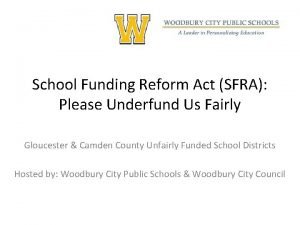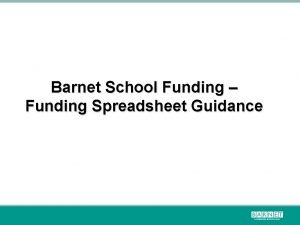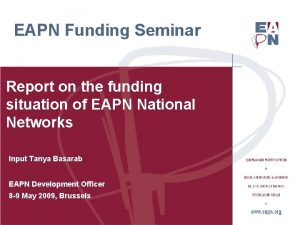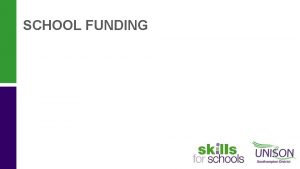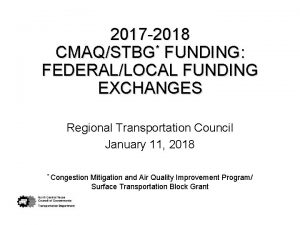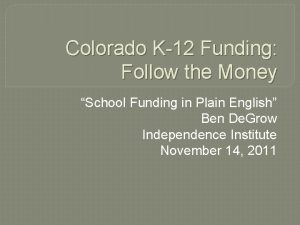School Funding Seminar 6 March 2017 School Funding















- Slides: 15

School Funding Seminar – 6 March 2017 ‘ School Funding Seminar- March 2017 1

School Funding Before 2010 q Between 1992 and 1997, the Government cut Education funding in real terms. q From 1997 to 2010, Education funding increased substantially in real terms and was protected between 2008 to 2010 from the impact of the recession. q Up to 2010, the Government’s minimum funding guarantee (the amount by which real terms per pupil funding will increase in each school) was a positive figure. q The trend from 1990 onwards was for increased delegation from local authorities to schools, but there was some local authority autonomy over the level of delegation. q By 2010 the Government was taking steps to curb excessive unspent balances in schools. School Funding Seminar- March 2017 2

School Funding after 2010 q Education funding has not increased in real terms – only by inflation. q The minimum funding guarantee (per pupil protection against funding losses on an individual school basis) became a negative figure – minus 1. 5%. q Increased delegation has meant that many school budgets have grown by more than the rate of inflation – but local authority funding has been squeezed. q The Comprehensive Spending Review from 2014/15 to 2019/20 provided for inflation linked increases only in Education funding. q The NASUWT’s trade dispute against job loss has defended the jobs of teachers and support staff in this climate. School Funding Seminar- March 2017 3

School Balances q Df. E data demonstrates that: § for 2015 -16 the total revenue balance across all LA maintained schools in England was £ 2. 1 billion; § this amounts to an average revenue balance in each LA maintained school in England of £ 124, 000 (7. 5% of revenue income); § 6% of LA maintained schools in England are in deficit; § in the 93. 1% of schools in England in surplus, the average surplus in each primary school has increased by £ 8, 000 to £ 116, 000 and the average surplus in each secondary school has increased by £ 13, 000 to £ 391, 000; § unspent balances in schools in England amount to £ 4, 595 per teacher. q This data is on memory sticks, broken down school by school. q Academies funding data is on memory sticks also. Negotiating Secretaries' Briefing - January 2017 4

School Funding Reform q On 14 December 2016, the Secretary of State for Education reported to Parliament the Government’s Phase 2 consultation on its schools and high needs national funding formulae (NFF), to be implemented from 2018/19 onwards. The Government’s planned reforms encompass: § a new NFF for all schools and academies; § a new NFF for high needs pupils, allocated to local authorities (LAs); § a new Central School Services Block, allocated to LAs. q The Department for Education (Df. E) also published alongside the consultation LAlevel illustrative allocation tables for: § schools; § high needs; § central school services; § https: //consult. education. gov. uk/funding-policy-unit/schools-national-fundingformula 2 § https: //consult. education. gov. uk/funding-policy-unit/high-needs-funding-reform-2/ q More detailed school-level illustrative data was further published to individual schools through the COLLECT system. School Funding Seminar- March 2017 5

Df. E data q On your memory stick you have q National Funding Formula (NFF) data: § 2016/17 baseline funding for each school and local authority. § illustrative funding for each school and local authority, if the formula was implemented in full without any transitional protections. § illustrative Year 1 funding for each school in England local authority. § The data includes high needs funding and the central school services block. q 2016 school and academy budget data: § School deficits and reserves data for 31 March 2016 (the most recent data published) § Academy expenditure for 31 August 2015. q Key funding data for each school in England can be obtained. School Funding Seminar- March 2017 6

Timescales q The Df. E has confirmed: § there will be a ‘soft NFF’ in 2018/19, with LAs receiving the NFF allocation, but with schools receiving individual allocations in accordance with the local school funding formula; § from 2019 -20 onwards there will be a hard formula, with schools receiving individual allocations; § the Central School Services Block will be introduced in 2018 -19; § LAs will continue to receive high needs funding from 2019 -20 onwards through the high needs NFF. q School funding for 2017/18 is not linked to the NFF. q 2017/18 funding for schools will continue to be allocated by LAs in accordance with their local formulae into three blocks, which were published on 20 December 2016: § schools block; § high needs block; § early years block. School Funding Seminar- March 2017 7

The Future Role of LAs q LAs will continue to have a role in the provision of education after 2020, including: § maintaining schools; § providing key statutory services; § providing non-statutory services, including school improvement; § providing high needs education. q Funding for LAs will be provided by the high needs and Central School Services NFF. q Schools will be able to purchase services from LAs from 2019/20 onwards. q 2018/19 will be the final year for de-delegation, and from 2019/20 LA services will have to be provided via traded services agreements. q The future of schools forums is uncertain. q The NASUWT will continue to press the Government for trade union facilities release pots to be maintained by local authorities. School Funding Seminar- March 2017 8

The Future Role of LAs q In November 2016, the Secretary of State for Education accepted that the ‘dual system’ of LA maintained schools and academies would continue for the foreseeable future. q The Secretary of State announced that there would be a £ 50 million fund for LAs to continue to monitor and commission school improvement for low-performing maintained schools. q In addition, the Government would make available to maintained schools and academies a £ 140 million Strategic School Improvement Fund. q The Education Services Grant (ESG) will be wound up from September 2017, but there will be new grant funding for LAs’ statutory education duties. Transitional ESG LA funding from April to September 2017 was published on 20 December 2016. q Government policy on LAs and the provision of education has undergone a significant reversal, achieved by the NASUWT. School Funding Seminar- March 2017 9

What does the Schools NFF look like? q The NFF will be made up of four different factors: § basic age 5 to 16 per pupil funding (the age weighted pupil unit); § additional needs funding (deprivation, low prior attainment, English as an Additional Language (EAL) and mobility); § school-led funding (for premises, sparsity and growth); § geographic funding (the area cost adjustment which takes into account the local economy and cost of salaries). q Premises factors will be funded on the basis of historic spending. q Funding will be transferred for looked after children from the Dedicated Schools Grant (DSG) to the pupil premium plus. q The Government is not pursuing its proposals for a locally variable minimum funding guarantee (MFG). The proposed MFG remains at minus 1. 5%. School Funding Seminar- March 2017 10


What does the schools NFF look like? q Pupil-led factors § The basic per-pupil factor is 72. 5% (76. 6% currently across all local authorities. § The deprivation factor is 9. 3% (7. 6% currently across all local authorities). § The low prior attainment factor is 7. 5% (4. 3% currently across all local authorities). § The EAL factor is 1. 2% (0. 9% currently across all local authorities). § The mobility factor is 0. 1% (0. 1% currently across all local authorities). q School-led factors § The lump sum factor is 7. 1% (8. 2% currently across all local authorities) – likely to go to small schools. § The sparsity factor is 0. 08% (0. 05% currently across all local authorities) – will go to small schools in largely rural areas. § The premises factor is 1. 8% (1. 8% currently across all local authorities and will be allocated on the basis of historic spend). § The growth factor is 0. 5% (0. 5% currently across all local authorities). School Funding Seminar- March 2017 12


What does the Schools NFF look like? q The national primary to secondary ratio is 1: 1. 29 (i. e. for every £ 1 that a primary school receives, a secondary school receives £ 1. 29). This is the current weighting across LAs in England. q The minimum funding guarantee (MFG) limits losses per year to 1. 5%. q Losses during the full life of the formula are limited to 3% (the funding floor). q Gains are capped at 3% in 2018 -19 and 2. 5% in 2019 -20. q The Government proposals are not for ‘voucher style’ funding – deprivation has a high weighting, as do historical school factors. This is an indication of the success of the NASUWT strategy of action and engagement with Government since the NFF became Government policy. q NASUWT engagement has mitigated the regressive impact of the NFF in historically high spending local authorities. School Funding Seminar- March 2017 14

What are the real inflation pressures on schools? q In 2015 and 2016 schools had to meet the costs of increased teacher pension contributions (2. 3%) and National Insurance (2%+). q The National Audit Office estimate of an 8% inflation pressure is from 2014/15 to 2019/20 – as well as pension and National Insurance costs which have already been met, this includes an estimate of the pressure of increased pupil numbers between 2017 and 2020. This will be reflected for schools in the growth factor in the NFF. q It is inaccurate to apply an 8% reduction to the NFF illustrative figures for 2016/17 and then say that this represents a ‘real terms budget’ for a school or local authority. q The NASUWT has campaigned and taken action for increased school funding since 2010. The NASUWT continues to argue that the Government has failed to invest sufficiently in the school system. q The NASUWT’s campaigns are always rooted in evidence – the NASUWT opposes alarmist and inaccurate propaganda about school funding which spreads panic and leads to unnecessary knee-jerk reactions. q Some schools and academies are declaring unnecessary redundancies, reducing terms and conditions and trying to charge parents ‘fees’, using inaccurate funding forecasts as the rationale for this. School Funding Seminar- March 2017 15
 Poland national anthem lyrics
Poland national anthem lyrics School funding reform act
School funding reform act Sophomore seminar high school
Sophomore seminar high school School workforce census 2017
School workforce census 2017 Grihalakshmi magazine march 2019
Grihalakshmi magazine march 2019 Vincent van gogh quotes about death
Vincent van gogh quotes about death Genetic engineering conclusion
Genetic engineering conclusion March 1917 revolution
March 1917 revolution Sherman's march to sea map
Sherman's march to sea map Sherman's march significance
Sherman's march significance Path of sherman's march to the sea
Path of sherman's march to the sea Path of sherman's march to the sea
Path of sherman's march to the sea Mist tccc
Mist tccc American idol
American idol January february march season
January february march season Patrick royston
Patrick royston

